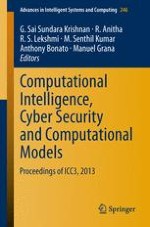This book contains cutting-edge research material presented by researchers, engineers, developers, and practitioners from academia and industry at the International Conference on Computational Intelligence, Cyber Security and Computational Models (ICC3) organized by PSG College of Technology, Coimbatore, India during December 19–21, 2013. The materials in the book include theory and applications to provide design, analysis, and modeling of the key areas. The book will be useful material for students, researchers, professionals, as well academicians in understanding current research trends and findings and future scope of research in computational intelligence, cyber security, and computational models.
